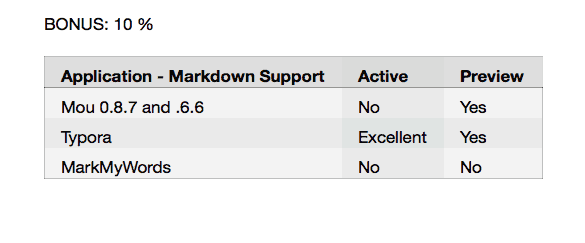

When you near a finished product, you change the output to the format of your choosing and then make the final touches.
#Table in markdown pdf
We recommend selecting the default HTML setting for now - it can save you time! Why? Because compiling an HTML document is generally faster than generating a PDF or other format. With HTML, you can easily view it in a web browser. When you open a new R Markdown file in RStudio, a pop-up window appears that prompts you to select output format to use for the document. R Markdown files have the file extension “.Rmd”. Now that R Markdown is installed, open a new R Markdown file in RStudio by navigating to File > New File > R Markdown….
#Table in markdown install
Use the following command to install R Markdown: install.packages("rmarkdown") R Markdown is a free, open source tool that is installed like any other R package.

If you’d like to learn more about RStudio, check out our list of 23 awesome RStudio tips and tricks! We’ll use the RStudio integrated development environment (IDE) to produce our R Markdown reference guide. With R Markdown, you have the option to export your work to numerous formats including PDF, Microsoft Word, a slideshow, or an HTML document for use in a website. R Markdown is powerful because it can be used for data analysis and data science, collaborating with others, and communicating results to decision makers. R Markdown is particularly useful when you are producing a document for an audience that is interested in the results from your analysis, but not your code. It enables you to keep all of your code, results, plots, and writing in one place. R Markdown is an open-source tool for producing reproducible reports in R. We encourage you to follow along by building out your own R Markdown guide, but if you prefer to just read along, that works, too!
#Table in markdown how to
We’ll show you how to convert the default R Markdown document into a useful reference guide of your own. By the end, you’ll have the skills you need to produce a document or presentation using R Markdown, from scratch! In this blog post, we’ll look at how to use R Markdown. Turn your data analysis into pretty documents with R Markdown.

PA <- sapply(PA, function(x) scales::percent(x, accuracy=.1))įormat.args = list(big.JGetting Started with R Markdown - Guide and Cheatsheet >#i Specify the column types or set `show_col_types = FALSE` to quiet this message. >#i Use `spec()` to retrieve the full column specification for this data. How do I get this not to display and what is this called? >#Rows: 6 Columns: 4 Below is what is being written before the table. I'm writing a report in Markdown and for some reason this this one table from a csv has these comments before it while the rest of my tables don't.


 0 kommentar(er)
0 kommentar(er)
